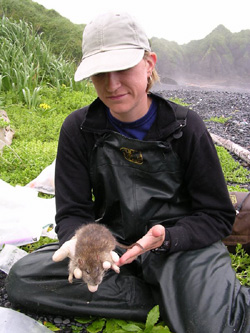This summer will see the first major rat eradication effort in the Aleutian Islands, prompted in large part by a study from the University of California, Santa Cruz, that appeared last month in theProceedings of the National Academy of Sciences.
The UCSC researchers discovered that the presence of rats on islands in the Aleutian Archipelago significantly affects the intertidal zone, decreasing the amount of seaweed and boosting the numbers of snails, barnacles and other invertebrates. Sea birds in island colonies are major predators of these creatures, and in their absence, the invertebrates take over, resulting in shorelines that are stripped bare of seaweed and algae. The presence of the rats simply decimates the seabird population, according to graduate student and study leader Carolyn Kurle.
“When you’re on an island with rats, there are so few birds, it’s silent in contrast to the cacophony on the islands without rats,” Kurle said in a press release announcing the findings. “Where there are no rats, we found plenty of birds, fewer invertebrates and a lot more algal cover.”
The results of the rat invasion are an example of the ecological phenomenon called “trophic cascade,” wherein a top predator causes ripple effects throughout the lower levels of the food chain. “This is a clear example of a trophic cascade that crosses between terrestrial and marine ecosystems,” Kurle said.
Kurle spent three summers running intertidal surveys on 32 islands — 17 with rats, 15 without — in the Aleutian Archipelago; at first she wore earplugs because the sounds of rats outside her tent were so loud. “We had to be careful with food and trash, but they never got into the tent or anything,” Kurle added in the press release. “They come out as soon as it starts to get dark, and we would see them running around everywhere. We spent several nights watching them through night-vision binoculars.”
But rats can be eradicated from islands. According to the Nature Conservancy, rats have been forcibly evicted from 274 islands around the world, including islands off the coast of Mexico and on Anacapa Island, one of the Santa Barbara Channel Islands in Southern California. The Anacapa eradication project ended in 2001, and in the past three years, the island’s population of the rare seabird Xantus’ murrelet has increased more than 80 percent.

Some of Kurle’s research colleagues are also the cofounders of Island Conservation, a nonprofit organization that aims to protect and restore island ecosystems. For the Aleutian Island rat eradication project, Island Conservation has teamed up with the Nature Conservancy and the U.S. Fish and Wildlife Service.
Sign up for our free e-newsletter.
Are you on Facebook? Become our fan.



